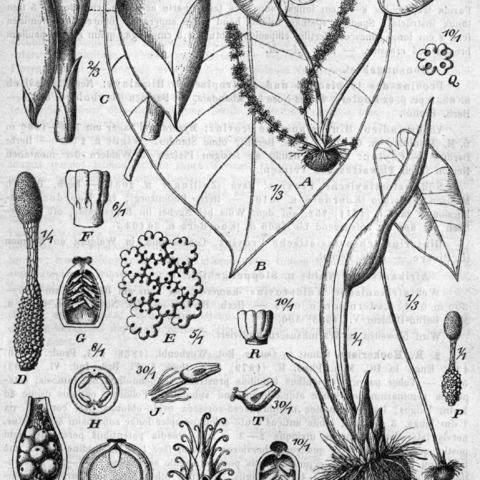Herbs, small to medium sized, seasonally dormant, epiphytic or epilithic, rarely terrestrial, latex-bearing. Tuber subglobose, producing erect to spreading, unbranched or branching stolons from axils of scarious, deciduous cataphylls; stolons producing small, ovoid tubercles at nodes, each invested by numerous apically hooked scales (minute cataphylls). Leaves 1 or 2; petiole sometimes slender, sheath relatively short; leaf blade peltate, cordate-lanceolate to cordate-ovate, apex acuminate; basal veins well developed, primary lateral veins pinnate, forming submarginal collective vein very close to margin, marginal vein also present, secondary and tertiary laterals arising from primaries at a wide angle, then arching toward leaf margin and forming inconspicuous interprimary collective veins, higher order venation reticulate. Inflorescences solitary or up to 3 together, appearing with or without leaf; peduncle shorter than petioles. Spathe strongly constricted between tube and blade, sometimes with secondary constriction above spadix (this group formally recognized as a separate genus: Gonatanthus); tube with convolute margins, persistent, enclosing female zone and sterile zone of spadix; limb yellow or red, longer than tube, fully expanded or remaining convolute and opening only at base, sometimes becoming reflexed (in Remusatia vivipara and R. yunnanensis), later deciduous. Spadix sessile or subsessile, much shorter than spathe; female zone subcylindric, ca. 1/2 as long as spathe tube, separated from male zone by much narrower zone of sterile male flowers; male zone ellipsoid or subclavate, fertile to apex, obtuse. Flowers unisexual, naked. Male flowers 2-or 3-androus; stamens connate into cuneate-clavate, 4-6-sulcate synandrium; fused filaments distinct; common connectives somewhat excavated at apex; thecae 4-6, oblong to ellipsoid, dehiscing by apical porelike slit; synandrodes each ± elongated. Pistils lacking associated staminodes; ovary subcylindric to subglobose, 1-loculed or partially 2-4-loculed at apex; ovules many, hemiorthotropous; funicle short to long; placentae 2-4 and parietal or placenta 1 and basal; stylar region very shortly attenuate or appearing lacking; stigma disciform-subcapitate or slightly 3-or 4-lobed. Fruit an obovoid to globose, many-seeded berry; infructescence ellipsoid, borne within persistent spathe tube. Seed ellipsoid to subglobose, covered by thick, fleshy sarcotesta or testa verruculose to irregularly costate; embryo axile, ovoid to subglobose, short; endosperm copious. 2n = 28, 42.
More
Fleshy, tuberous, seasonally dormant herbs; tuber producing aerial shoots bearing burr-like bulbils. Leaves often solitary, sometimes 2–3, subtended by several basal cataphylls; petiole fleshy with inconspicuous sheath, not pulvinate apically; blade peltate-cordate, ovate to lanceolate in outline; fine veins reticulate, arching towards margin. Inflorescence solitary, appearing before leaves. Spathe with lower part convolute into a tube with constricted apex, upper part an expanded limb, reflexed or ± cucullate. Spadix with basal part pistillate (extreme base with sterile pistillodes), central part slender, subconic, composed of ± prismatic sterile flowers, apical part composed of fertile staminate flowers, clavate-cylindric, stout, projecting beyond spathe-tube. Flowers unisexual, without perigon, densely congested. Staminate flower a truncate fluted synandrium composed of 2–3 connate stamens; anthers lateral, dehiscing by apical pores. Pistil ovoid; ovary unilocular or 2–4-locular in apical region; ovules numerous on 2–4 parietal placentas; stigma sessile, discoid to subglobose. Berries included within persistent spathe-tube, subglobose, many-seeded. Seeds with copious endosperm; embryo axile.
Epiphytic, lithophytic or terrestrial, cormous, deciduous herbs, with erect to dangling unbranched to much-branched stolons bearing numerous ovoid bulbils clothed in small hooked cataphylls. Leaves 1–several together, produced after or with the inflorescence; blade broadly ovatosagittate, peltate, not glaucous. Inflorescences 1–several in series, subtended by cataphylls; spathe constricted (sometimes twice); limb tongue-shaped to obovate and erect, becoming strongly reflexed, then deciduous; lower spathe persisting into fruit; spadix shorter than spathe, as for Colocasia but interpistillar staminodes absent, male zone subclavate to clavate, appendix absent. Fruit exposed by dehiscent lower spathe. Seeds small, numerous.

